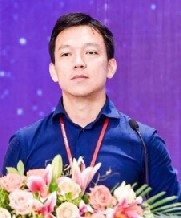Keynote Speakers
Dr. Rongrong Ji, Professor
School of Information, Xiamen University, ChinaSpeech Title: Compact Visual Representation – Effectiveness, Interpretability and Robustness
Abstract: This talk mainly introduces a few representative compact computer vision models for visual recognition and retrieval on massive datasets. It covers the main progress of Prof. Rongrong Ji’s research group on compact visual representation, feature interpretability, and robust visual analytics. For the issue of representation compactness, a ranking-sensitive hashing model will be introduced, which can effectively preserve the ranking information of data in the Hamming space by learning from large-scale unsupervised data pairs. For the interpretability issue, this talk will report recent developments of diverse feature learning, feature coupling & decoupling analysis, as well as the structural decomposition of neural networks. For the robustness issue, an in-depth investigation on the sensitivity of adversarial samples in visual retrieval tasks will be presented and discussed. Finally, this talk will highlight some typical industrial applications of the above research achievements in recent vision-related products of leading AI companies such as Huawei and Tencent.
Keywords: Compact Visual Representation; Robustness; Interpretability
Biography: In 2011, Rongrong Ji obtained his doctorate from professor Yao Hongxun in Harbin Institute of Technology. In 2010, he worked as a research assistant in academician Gao Wen laboratory of Peking University. From the end of 2010 to 2013, he worked as a postdoctoral researcher in Shih-Fu Chang laboratory of Columbia University. In 2013, he joined the department of intelligent science and technology, school of information science and technology, Xiamen University. He was appointed as a full professor at Xiamen University in 2014 and he has been Minjiang Scholar distinguished professor since 2015 at the same university.
His research falls in the field of computer vision, multimedia, and machine learning. His scholarly work mainly focuses on leveraging big data to build computer systems to understand visual scenes and human behaviors, inferring the semantics and retrieving instances for various emerging applications. His recent interests include compact visual descriptor, social media sentiment analysis, and holistic scene understanding. He has published over 70 papers in top journals and reputed conferences like PAMI, IJCV, TIP, CVPR, ICCV, IJCAI, AAAI and ACM Multimedia.
In the past decade, Prof. Ji and his collaborators have developed some of the state-of-the-art mobile visual search systems and social multimedia analytics tools, with top performances in the MPEG Compact Descriptor for Visual Search (CDVS) standard evaluations. His work has also been recognized by ACM Multimedia 2011 Best Paper Award, Microsoft Fellowship 2007, and Best Thesis Award of Harbin Institute of Technology. His research has been supported by government agencies like National Science Foundation of China. He has been awarded the National Science Foundation for Excellent Young Scholars (2014). In 2017, he was awarded the National Top Talent of Ten Thousand People Program.
He is associate editors in Neurocomputing, Multimedia Tools and Applications, The Visual Computer, PLOS ONE, Frontiers of Computer Science etc., guest editors in ACM Transactions on Intelligent Systems and Technology, IEEE Multimedia Magazine, Signal Processing, Neurocomputing etc., General Chair of VALSE (Vision And Learning SEminar) 2017, Local/Session/Area Chairs in IEEE MMSP 2015, ACM ICMR 2014, IEEE VCIP 2014, ACM MMM 2015, IEEE ISM 2015 etc. TPC Members in AAAI 2015, CVPR 2013, ICCV 2013, ACM Multimedia 2010-2015 etc. He has been a Senior Member of IEEE (2014-now), Senior Member of ACM (2015-now), Chair of VAIG Group for IEEE Multimedia Communication Technical Committee (MMTC) (2014-2016), Member of ACM, Chair of CCF YOCSEF Xiamen (2016-2017), and Executive Member of Fujian Association of Artificial Intelligence.
Dr. Juan Manuel Corchado, Professor
Director - European IoT Digital Innovation HubDirector - BISITE Research Group, University of Salamanca, Salamanca, Spain
Speech Title: Blockchain, Edge Computing and Artificial Intelligence
Abstract: Artificial Intelligence (AI) is the driving force of growth in the world and therefore it is an extremely topical subject nowadays. The ever-greater developments in the field of artificial intelligence have sparked conversations of its potential in different sectors (society, business, government, etc). AI has been here for ages but now we have all we need to make it a reality; computing power, storage capacities, communications technology and man power. With all these resources we can become more efficient by incorporating AI into our daily activities.
Blockchain is the technology behind bitcoin, ether and most of the other cryptocurrencies. Blockchain is essentially a form of record keeping and can be used in almost any product that uses some form of record keeping or database management. Blockchain is ideal for protecting any data that must be unalterable and indestructible.
Edge Computing streamlines the flow of traffic from IoT devices and provides real-time local data analysis. Instead of a centralized data-processing warehouse, this paradigm processes the data near the edge of the network, where the data is being generated. Edge computing accelerates data-streaming, including real-time data processing without latency. It allows smart applications and devices to respond to data as they are being created, this almost instantaneous response eliminates lag time. This is critical for technologies such as self-driving cars and has equally important benefits for business.
Biography: Juan Manuel Corchado is Full Professor with Chair at the University of Salamanca. He was Vice President for Research and Technology Transfer from December 2013 to December 2017 and the Director of the Science Park of the University of Salamanca, Director of the Doctoral School of the University until December 2017 and also, he has been elected twice as the Dean of the Faculty of Science at the University of Salamanca. In addition to a PhD in Computer Sciences from the University of Salamanca, he holds a PhD in Artificial Intelligence from the University of the West of Scotland. Juan Manuel Corchado is Visiting Professor at Osaka Institute of Technology since January 2015, Visiting Professor at the Universiti Malaysia Kelantan and a Member of the Advisory group on Online Terrorist Propaganda of the European Counter Terrorism Centre (EUROPOL).
Corchado is the Director of the European IoT Digital Innovation Hub and of the BISITE (Bioinformatics, Intelligent Systems and Educational Technology) Research Group, which he created in the year 2000, President of the AIR Institute, Academic Director of the Institute of Digital Art and Animation of the University of Salamanca and has been President of the IEEE Systems, Man and Cybernetics Spanish Chapter. He also oversees the Master´s programs in Digital Animation, Security, Blockchain, IoT, Mobile Technology, Information Systems Management and Agile Project Management at the University of Salamanca.
Corchado has supervised more than 25 PhD theses, is author of over 800 research peer review papers and books, has chaired the scientific committee of more than 30 international conferences, and is also Editor-in-Chief of Specialized Journals like ADCAIJ (Advances in Distributed Computing and Artificial Intelligence Journal) and OJCST (Oriental Journal of Computer Science and Technology).
Dr. Milan Tuba, Professor
Vice Rector for International Relations, Singidunum University, SerbiaSpeech Title: Recent Advances in Digital Image Classification
Abstract: Digital images introduced big changes in the world. Besides using digital images in everyday life, they became an irreplaceable part of numerous scientific areas such as medicine, security, agriculture, etc. One of the usual tasks in applications with digital images is digital image classification. Great progress in solving this task was made in recent years by convolutional neural networks. Convolutional neural networks represent a special class of deep neural networks that take a spatial correlation of input data into consideration. The results achieved by CNN are significantly better in comparison with the other classification methods. To use a CNN for a specific classification problem it is necessary to find the optimal network architecture and set various hyperparameters such as the number of different layers, number of neurons in each layer, optimization algorithm, activation functions, kernel size, optimization algorithm, etc. Frequently, CNN’s configuration is based on some previous experience or knowledge or set by guessing and estimating (guestimating) better values for the hyperparameters. Recent studies achieved promising results when using swarm intelligence algorithms for CNN’s hyperparameters tuning. A few examples of using swarm intelligence algorithms for convolutional neural network hyperparameter tuning will be presented.
Biography: Milan Tuba is the Vice Rector for International Relations, Singidunum University, Belgrade, Serbia and was the Head of the Department for Mathematical Sciences at State University of Novi Pazar and the Dean of the Graduate School of Computer Science at John Naisbitt University. He received B. S. in Mathematics, M. S. in Mathematics, M. S. in Computer Science, M. Ph. in Computer Science, Ph. D. in Computer Science from University of Belgrade and New York University. From 1983 to 1994 he was in the U.S.A. first at Vanderbilt University in Nashville and Courant Institute of Mathematical Sciences, New York University and later as Assistant Professor of Electrical Engineering at Cooper Union School of Engineering, New York. During that time he was the founder and director of Microprocessor Lab and VLSI Lab, leader of scientific projects and theses supervisor. From 1994 he was Assistant Professor of Computer Science and Director of Computer Center at University of Belgrade, from 2001 Associate Professor, Faculty of Mathematics, University of Belgrade, from 2004 also a Professor of Computer Science and Dean of the College of Computer Science, Megatrend University Belgrade. He was teaching more than 20 graduate and undergraduate courses, from VLSI Design and Computer Architecture to Computer Networks, Operating Systems, Image Processing, Calculus and Queuing Theory. His research interest includes nature-inspired optimizations applied to computer networks, image processing and combinatorial problems. Prof. Tuba is the author or coauthor of more than 200 scientific papers and coeditor or member of the editorial board or scientific committee of number of scientific journals and conferences. He was invited and delivered around 60 keynote and plenary lectures at international conferences. He has been member of the ACM, IEEE, AMS, SIAM, IFNA.



